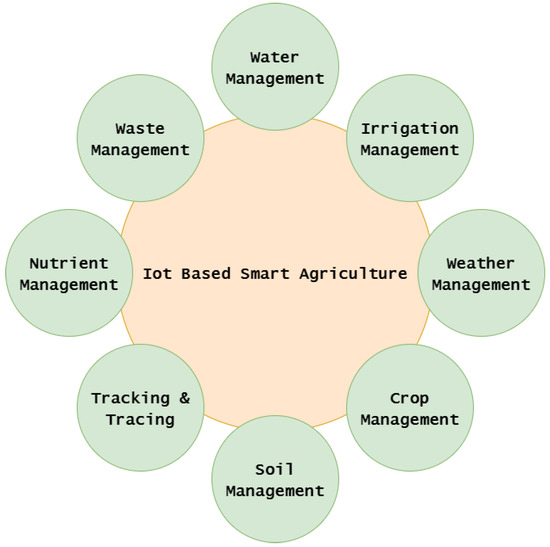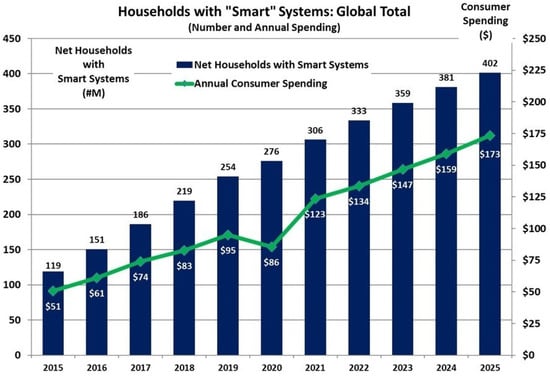You're using an outdated browser. Please upgrade to a modern browser for the best experience.
Please note this is a comparison between Version 1 by Robin Chataut and Version 2 by Wendy Huang.
The Internet of Things (IoT) technology and devices represent an exciting field in computer science that is rapidly emerging worldwide. The demand for automation and efficiency has also been a contributing factor to the advancements in this technology. The proliferation of IoT devices coincides with advancements in wireless networking technologies, driven by the enhanced connectivity of the internet. Nearly any everyday object can be connected to the network, reflecting the growing demand for automation and efficiency.
- IoT
- healthcare
- agriculture
- smart home
- smart cities
1. Introduction
The Internet of Things technology revolves around the core concept of integrating sensors into everyday objects and using connectivity to facilitate the exchange of information that is used in a variety of applications [1]. There are more everyday objects available than people, so the amount of connectivity that IoT devices hold is enormous [2]. In order to better understand the future of IoT technology, it is important to understand the unique circumstances that brought IoT to this point. A key distinction to make between the internet and the IoT is that the internet is a mesh of networks, whereas the IoT network is an interconnected network of devices [3][4][3,4]. An early example of the first IoT device was John Romkey’s creation, which enabled a toaster to be turned on or off over the internet in 1990 [5]. It is clear that Internet of Things devices have come a long way from their humble beginnings, and there are many factors that influenced this rise. These devices play an important role in people’s daily lives and involve the handling of massive amounts of data [6]. IoT devices can be seen as a network of interconnected devices that involves sending and actuating devices that provide the ability to share information across different platforms [7][8][9][10][11][12][13][14][15][16][17][18][19][20][21][7,8,9,10,11,12,13,14,15,16,17,18,19,20,21].
2. Healthcare Applications
The Internet of Medical Things (IoTM) is an emerging subfield that is changing the way healthcare is being delivered through the use of IoT technology (Joyia). The use of IoT technology in healthcare has come a long way and continues to be a promising area for growth. Essential innovations, such as the AliveCor heart monitor, which relies on IoT sensors, show how useful technology can be when applied to healthcare in efforts to save lives [22][84]. Advances in technology have consistently played a major role in the healthcare industry, and IoT devices have found numerous applications in healthcare settings. One way that IoT devices are useful in healthcare is through the use of remote health monitoring in order to monitor patients at home rather than in hospitals [23][85]. The information that is collected from IoT devices is helpful in medical settings because it can be analyzed and used in ways such as early disease prediction [24][86]. IoT sensors even played a critical role during the COVID-19 pandemic in helping healthcare workers better monitor critical parameters that could save lives if changes were detected right away [25][87]. By examining these different IoT device applications in the healthcare industry, researchers can find additional ways to advance this field of research. The use of sensors is critical in the delivery of healthcare services [26][88]. Sensors in medical devices act as a bridge between the physical and information worlds by collecting a variety of data. Sensors are crucial in helping healthcare professionals monitor different vitals that are important to measure in order to understand a person’s health situation and act accordingly. Medical sensors can be used in a variety of ways in order to measure crucial information. Medical sensors are connected to IoT, and measure things such as temperature, respiration, heart rate, weight, skin conductance, galvanic response, blood flow/SpO2, glucose testing, muscle contraction, and motion analysis [27][89]. The medical sensors are connected to wireless sensor networks, which relay useful information to different stakeholders involved in healthcare, such as patients, medical staff, insurers, and more [28][90]. The use of medical sensors is vast and can be used in crucial medical equipment, such as ECG monitors, glucose level sensing, and oxygen monitoring [29][91]. The goal of using any technology involved in healthcare is to promote better health outcomes, and IoT devices play a critical role in promoting this. Recent advances in IoT-related technology will continue to play a large role in creating stronger healthcare systems, and the future of healthcare will become increasingly reliant on technology [30][92]. Medical sensors are important in collecting useful information about a patient’s health; however, this information is often very sensitive in nature, and this makes privacy a major concern moving forward. Security has always played a vital role in IoT technology; however, it matters even more in a situation such as healthcare, where IoT devices will be collecting sensitive information about patients that is private in nature [31][93]. If a patient’s medical information was compromised, this could lead to consequences for hospital organizations that did not employ the proper security measures to prevent it. The privacy and confidentiality of a patient’s medical information are core concerns when addressing the security vulnerabilities of healthcare IoT devices [32][94]. There are many issues that present challenges to the successful use of IoT devices in healthcare and it is important to address these issues thoroughly when handling mission-critical operations, such as that of healthcare. Some important limitations that influence the use of IoT technology in medical devices include the need for high power consumption, the availability of limited resources, and handling security issues from the large number of devices being used [33][95]. The use of IoT technology in healthcare is promising and exciting. There are many useful applications where IoT devices can be used as sensors, and this helps healthcare providers in a variety of ways. Moving forward, IoT technology will continue to expand, and this will ultimately benefit healthcare organizations.3. Agriculture Applications
As the population of the world grows at an exponential rate, the need for efficient food delivery systems is becoming a core issue that is a driver behind the advancements in smart agriculture [34][96]. In addition to the growing demand, factors such as climate change and water scarcity have also played roles in the increasing demand for more efficient agriculture systems [35][97]. Much of the technology around IoT implementation aims to reduce agricultural resource waste [36][98] as shown on Figure 1. The use of IoT technology in agricultural settings is critical to maintaining efficient operations and represents another common use case of IoT technology. Food supply chains that deliver quality and quantity are important to feed the world, and having efficient systems built around these supply chains will benefit people all over the world [37][99]. The need for more efficient food-delivery systems has helped to promote IoT use in agriculture because stakeholders saw the benefits that technology could provide [38][100].
Figure 1.
Different types of agriculture applications for IoT.
4. Smart Home Applications
Smart home applications represent promising use cases in which people benefit from IoT technology and there are numerous advantages/disadvantages to consider. Smart home devices date back to the 1970s when the X10 protocol was first conceived; this technology allowed for smart home devices to communicate properly [48][110]. IoT devices in smart homes can be used in a variety of ways, such as measuring home conditions, managing home appliances, and controlling home access [49][111]. Home automation remains a core feature around which IoT technology is applied [50][112]. For example, there are numerous home appliances that can be turned on and equipped with IoT technology in order to become more efficient and convenient [51][113]. There are many benefits that extend beyond convenience. The use of IoT sensors in smart homes can be used to assist the elderly in turning hard-to-reach devices on/off and even detect falls through the use of floor or camera sensors [52][114]. The market is being driven by the rising popularity of smart devices, such as speakers offered by Amazon and Google. According to a recently released report by Strategy Analytics, the global smart home market has had a positive outcome in recent years [53][115]. The report further estimates a compound annual growth rate (CAGR) of 10% from 2018 to 2023, leading to a market value of USD 155 billion, as shown in Figure 2.
